In the photo, natural soaps - household (white and brown) and moisturizing, olive (yellow)
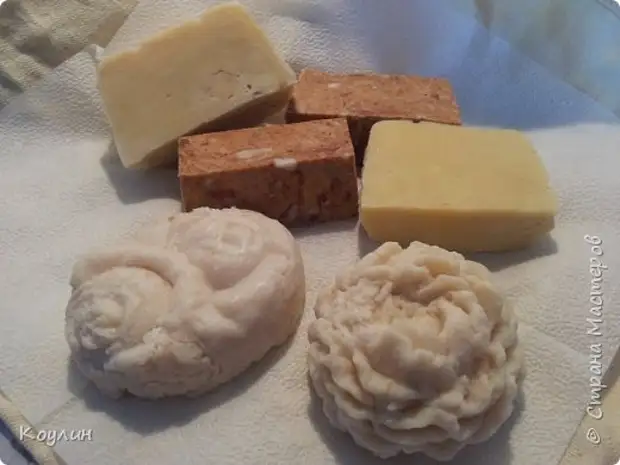
So my lavender soap looks like. It is with lavender flowers and lavender aroma (E.M. Lavender).
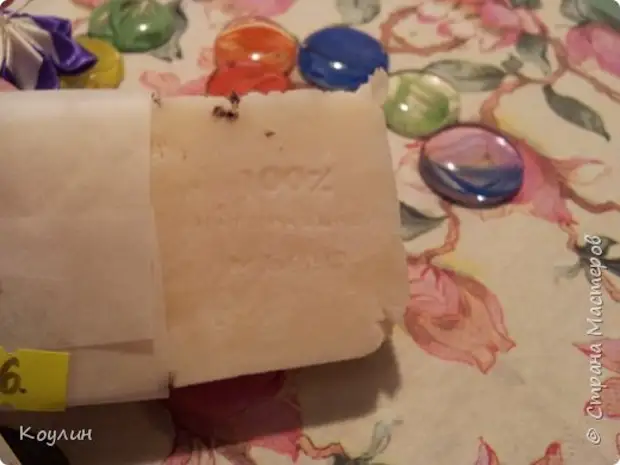
Here is such a soap with shea butter - well suited for people from 40+. =) Smoothes small wrinkles, protects against external environmental impacts, feeds, etc.
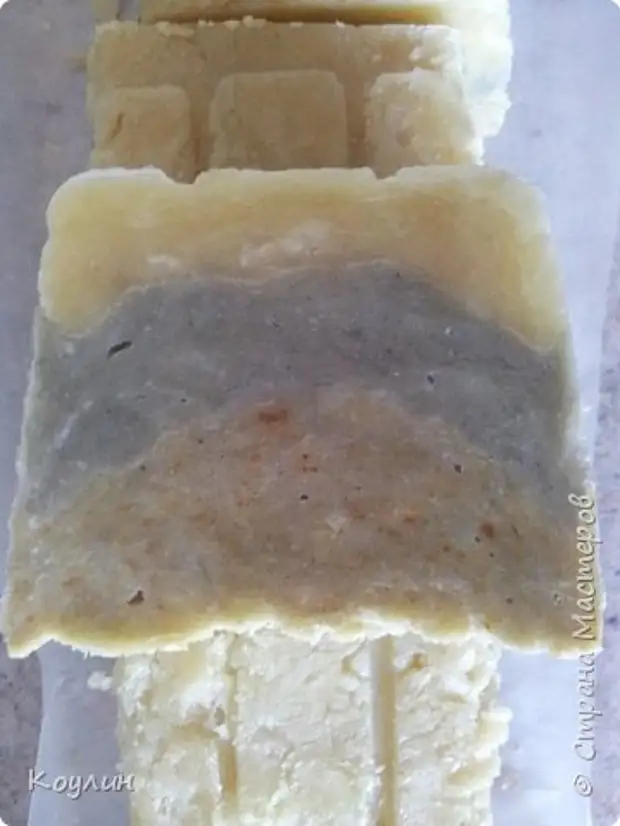
So usually packaged my soap + mini passport. It is the composition, the date of manufacture, etc.
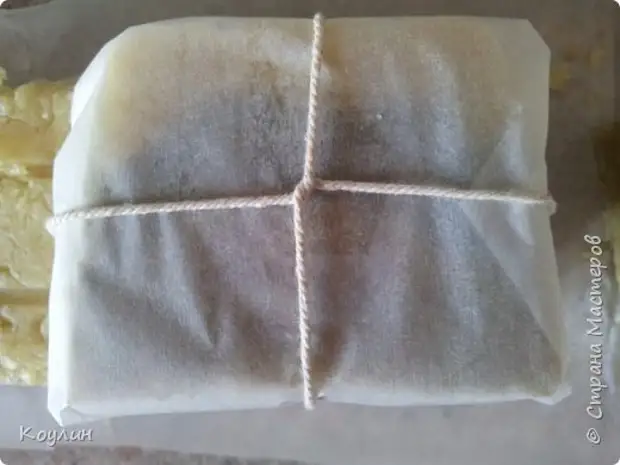
Here is the design of the water bath. If you look closely, the water level is visible.
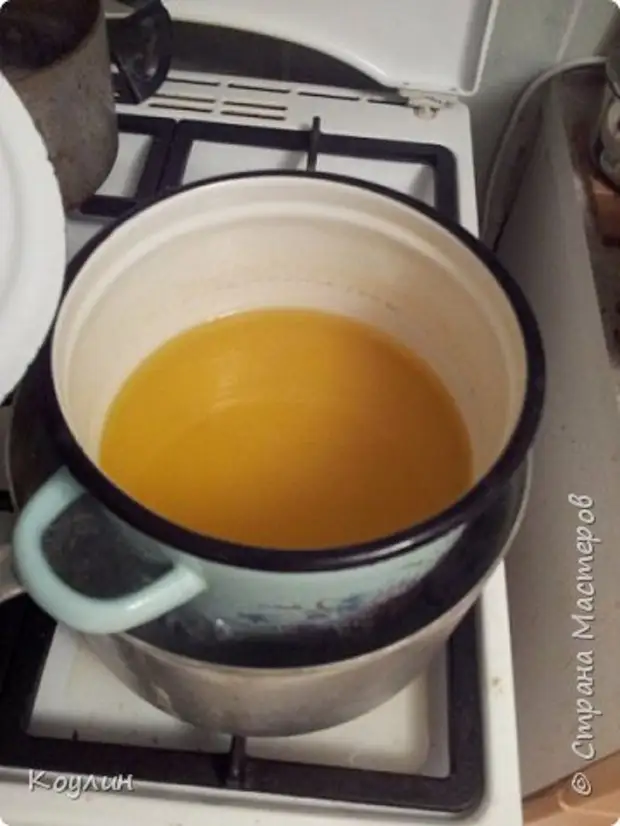
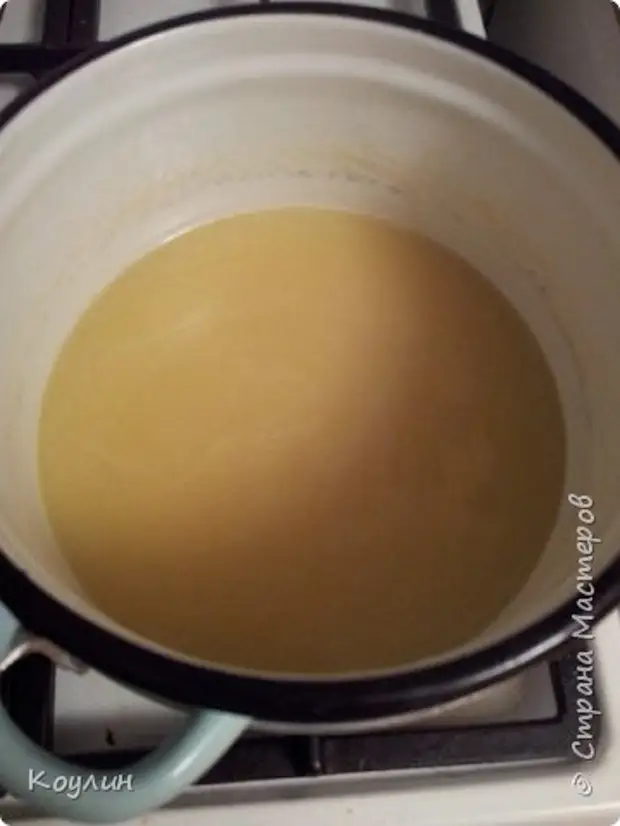
As the boiled soap brightens and thickness =)
My protective equipment =)
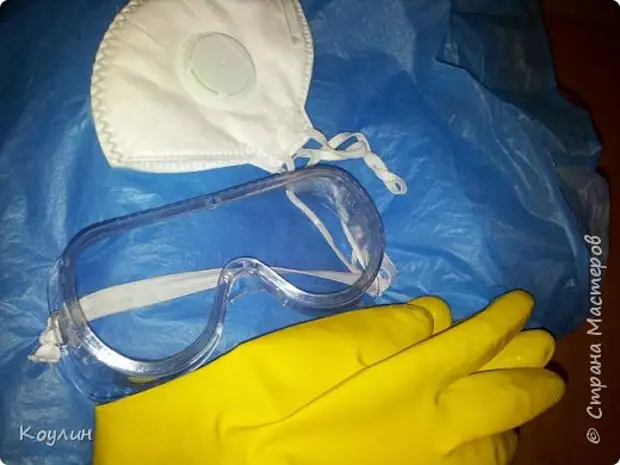
Collecting components in the workplace =) You can even make a list that would not forget what))
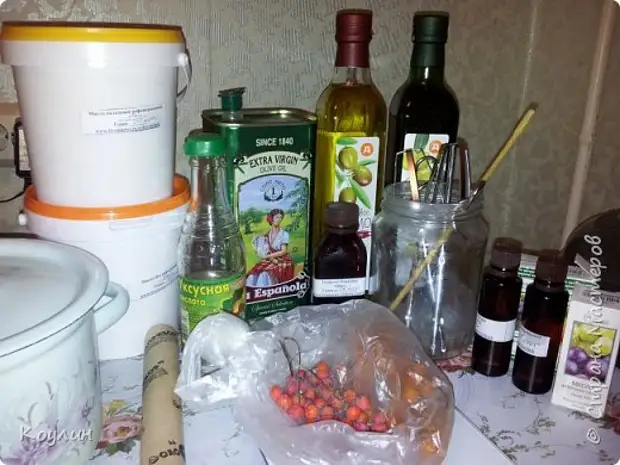
=) How to cook soap some people know about. I will allow myself here to write small notes to help for beginner soaps and at the end to give an example of cooking soap. I want to say right away that for me the criterion of soap is its naturalness and safety.
What do you need to cook soap from scratch?
Be sure to:
Butter (oil used for washing - reactions with alkali).
Alkali - naone or con.
Rerazyr - useful oils that are added at the end of the preparation of soap do not react with alkali, and added as nutrient, moisturizing, caring. Increasingly, this is not refined oils in which all natural useful substances are preserved.
Scales - weigh all components to tenth grams.
Thermometer is glass or infrared.
Safety glasses - to protect the eyes from alkali.
Respirator - to protect the respiratory organs from the vapor alkali + that again the alkali does not splash on the face.
Protective clothing - should be easily and quickly removed. It is desirable - not to skip alkali.
Gloves - =) Hand protection.
Water is needed for the preparation of alkali solutions.
Vinegar - neutralization of alkali.
Napkins - wipe the thermometer, wipe what poured.
Additionally:
Mixer - =) Very helps in work. It would even write it as mandatory, but some cost "mixers".
PH Testers - Checking soap readiness.
Essential oils (EM) - used as natural flavors.
Clay - scrub, care, natural dye.
et al. =)
*********
What do you need to cook soap from scratch? Schill + oil. Many want without chemistry and ask - is it possible to make soap without alkali? Not. If there is no alkali, then soap will not do. Previously, as a spin, ash used. Nowadays, high-purified alkali con (with its help liquid soaps are made) and NAON (it makes a solid soap with it).
I cook soap from scratch natural, but many manage to call natural soap from scratch and I will not agree with that. When the same fragrances and dyes are beginning to add in soap (which we don't know the composition most often), preservatives, etc. - I can't call the soap to natural.
So. You decided to cook soap from scratch. You need alkali and basic oil (butter). This is for the beginning, the main composition, and there are still oils that are added at the end of preparation and just they care for our skin, moisturize it ... We usually call such oils. The surger is usually from 5 to 15% in the toilet soap and 1-5% in the economic.
Alkal is there, oil is. Did not forget about security? Be sure to need glasses, respirator, gloves and protective clothing, which can be quickly and easy to remove if the alkali solution falls on it. =) To be honest, I use a rainboard from above. It is easy to remove and alkali him like it did not have corrosion.
Do you think everyone? Not! We will also need scales up to the tenth grams - you want soap soap, it means you need to precisely weigh and alkali and oil and water. Also necessarily need a thermometer. For beginners, the cheapest is glass. If you want it to be done constantly, then you can take infrequiry (it is more expensive). This thermometer has 2 advantages - no need to wipe it after dipping into the oil and alkali and it does not bother as glass.
If I spoke about the thermometer. We mix the oil and alkali in one temperature +/- 2 from 40 to 60 degrees. This is optimal, although some are not observed. If you pour with the difference of temperatures - the same oil can begin to spit ...
Features of water bath.
If we talk about a water bath, and I do soap on the bath, then I immediately want to clarify. I have two saucepans. In one I put another. Water pouring so that it would be at least half a small pan closed. The reason is simple when water surrounds a small saucepan - soap is brewed faster. When water evaporates (there were such moments), boils below the level of a small saucepan - less temperature and soap have to boil longer.
How much do you need to cook soap? Differently. I have 2-3 hours on the bath. When I cooked soap for the first time - I kept 6-8 hours =) I did not know how to and worried that soap would not be disabled.
To do this, you need to know how to check the soap for readiness.
I want to immediately note that during the cooking soap I often come to him to prevent him. It is disturbed once every 30 minutes, I prevent at any time as I remember - as a result, it turns out more often).
Checking soap readiness.
I can select two ways to check:
- PH check using an indicator. It can be litmus paper or liquid. When the soap is ready pH will be about 8. Soap cannot be neutral, it is always alkaline. Most of the soaps do not trust this method and use method 2, as they believe that the indicators often "lie". I can understand them ..)
- Specify language. Not a very "healthy" option, but the most accurate one. When my soap is brewing for more than 2 hours I take a little soap into the tongue - if the pins - soap is not ready. If it does not pinch and felt "the taste of soap" - soap is ready. If soap has shipped - I immediately wash with water! Why pins? This alkali has not yet completely reacted with butter.
Soap weight.
After the soap is welded, it gradually loses weight - excessive moisture evaporates. I usually have a label on each soap where weight with grams. It is believed that soap that ceased to lose weight ripened. So believe when they make it a cold way, but I think it applies to hot. Yes, soap made by a hot way (as I tell here) you can use almost immediately. If you give him to lie down - it will be better than characteristics. Without excess moisture, it is less spent, less "kitchen" in the soap.
Vinegar
Vinegar, or acetic acid is necessary to neutralize alkali. I hold a variety of vinegar solution, if you suddenly need to neutralize the spilled splashing alkali. You can also wipe the working surfaces after cooking soap.
Water
Water is needed for the preparation of alkali solution. Preferably purified water, as the usual from under the tap can affect the characteristics of the soap. For example, I have very rigid water from under the tap, so you can use either filtered water or from a bottle.
Slippet.
You can use napkins, toilet paper, but not desirable rags. It is not advisable to wipe several times. Every time a small new piece.
Essential oils (E.M.)
Essential oils are used as natural flavors, but be careful. Some people may have allergic reactions to natural essential oils, so if you decide to make a soap for a child, or a person exposed to allergies - do not use E.M. in soap. =) To the sequence of the moment I have not met people who would have been such an allergy, but I think it is obligatory to warn about it.
Clay
Clay is added to soap as a light scrub, care and nutrition, natural dye. Clay are of different colors - white, blue, green, black ... All these colors are not bright, but harmoniously color soap. I want to immediately notice that clay care is like to divide - for the whole body, for the skin of the face ...
So. All collected, start cooking soap!
1. Think about the recipe! What soap without a recipe? You can take a ready-made recipe on the site, you can make it yourself on the soap calculator (there are plenty of them quite a lot on the Internet). =) And again I will draw your attention to the fact that soap may not work according to the recipe. Why? Because the characteristics of the same oils can be a bit different. So, depending on the source materials, there may be different results. Why am I using a soap cavulor? In order to find out how many alkali do I need. The percentage of oils I choose myself, even if the calculator does not like it, but it is already on my fear and risk. The calculator can be right, and it may be mistaken and it will turn out instead of the predicted "bad" soap simply "excellent" in all respects. =) Beginners still advise at the beginning to adhere to the "tips" of the soap calculator. So. Recipe we are ready. Today I will give an example one of my recipes.
Soap "olive".
Oil for washing:
Olive 74% - 500 gr.
Coconut 19% -125 gr.
Palm 7% -50 gr.
Naone (Soap will be solid) - 96.41 by calculator (on different calculators the number can be very different)
Water - 222.75 by calculator, but I would take smaller - then the soap is faster than the extreme moisture - I can use before. How less? Took about 120-150 g.
Write a recipe on a piece of paper and put on the workplace where you will do soap.
2. Collect everything you need to prepare soap in one place, so that you would not look for the necessary things along the soap.
The working surface can be displayed with a film.
3. Put the water for water bath.
4. Weigh on oil scales (we have an etame - olive and solid - coconut and palm) and putting them into a small saucepan. Let it bask all over the water bath.
5. Shoot the cork with the sink and get cold water there in such a way that weighted water for alkali in the dishes did not turn over, while preferably the maximum amount of water around it.
6. Weigh the water to react with alkali on the scales. Lower dishes with water in the sink. Immediately I want to draw your attention to the fact that during the reaction of alkali with water there is a huge amount of heat. My thermometer always shows more than 80 degrees, despite the fact that I am lowered it at the beginning of the reaction, when the temperature, if I'm not mistaken more than 100 degrees. For such mixing, and we always pour alkali into the water (not the opposite!) We need heat-resistant dishes. I have this bank. At the same time I want to notice - the dishes should be not only heat-resistant, but also not to join the reaction with the alkali, so I use the glass.
7. We are weighing on the scales of alkali, after which I slowly fade it into a constantly cooling out outside water. The solution must be mixed well from the very beginning. If you do not do this immediately - the bottom may form something like a crust of alkali - we do not need this =)
8. The thermometer is entering the course of history. After each measurement, wipe it with a napkin. They lowered in the alkali - rubbed .. lowered into the oil - rubbed .. omitted .... and so until the temperature and there and there will not be the same.
9. Oil and alkali of the same temperature. Gently take utensils with alkali (you feel what warm?). We pour neatly alkali into the oil constantly stirring. The oil immediately flies. The reaction begins.
10. Next, the mixer is whipped with alkali soap while it does not thicken, up to the stage of the trace. Track. What is a trace? This is when you spent something on the soapy mass and there remains a mark, which does not disappear so far.
11. We put on a bath until readiness.
12. In the course of cooking and stirring every 30 minutes, you will notice the gel stage. Do not be scared =) it should be. By the way, soap that we lay in the dishes, during cooking increases in volumes. So it is not necessary to make soap masses to the top - and it will run away))
13. Soap boiled! Remove from the bath and give a little cool. We add a surger, other useful components. When the temperature reaches 50 degrees (approximately), you can add essential oils. For larger temperatures, they will destroy and soap will remain without fragrance.
14. Layout soap shape. Watch that there was no emptiness. After that, I usually burn soap and leave in a dark, warm place for a day.
15. Take out soap from the form and cut.
16. We use food paper for storage - it gives to breathe soap (soap should breathe, evaporate the excess moisture). Cannot be stored in polyethylene.
=) You can use.
Suddenly remembered ... Children's soap - many think it is natural ... Unfortunately, even the basis for soap is not natural - there are chemistry everywhere. There is a truth one exception. Soaps have already learned how to make the basis for soap from scratch. If you have children, animals and you are afraid of them (there are all the same work with alkali), it is better to order from scratch from scratch. From homemade soap with "Children's" and with the "Basics" I would refuse. More precisely .... not what I would refuse ... =) I do not do them. After the first test - the foundations for soap moved to purely "zero"))
=) What else want to add. The first soaps are a photo old, but loved)) I have been doing soap ... - Soon there will be a year. During this period, a lot of things tried. Constantly trying new, learning from others. Made soap to order. And more ....
When you wash the apartment, unlike normal people, wash not only soap, but also from soap;)
In the bathroom counted 11 different pieces of soaps .. I still want to try))
=) It did not stop on the soap, it was still on the balms, hydrophilic tiles ... I remembered how everything from bombing for baths began)) thought about how to replace all cosmetics on natural.
=) I will be glad to any reviews. Do not scold much if something is wrong)) I wanted to share personal experience, namely, the subtleties ... Those trifles that .. like trifles, and strongly affect the result)
A source
